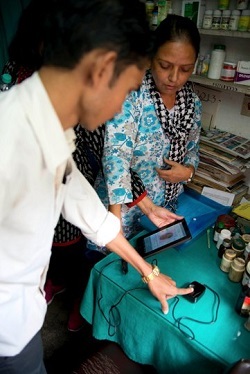Technology is a two edged sword. It is up to humans to decide what they will do with it. We can use it for the betterment of mankind, or we can use it to wipe out millions. It is up to us. It is our decision, and ours alone.
Technology - can it destroy?
There are those who invest huge resources in developing technology applications to perpetuate war and terror, who use the might of social media to spread hate and recruit killers. Smart phones are being used to train little children in acts of violence. Killers use scientific knowledge to develop weapons of mass destruction. This is an era where human suffering has crossed all bounds, where compassion and reason have lost their way in a morass of hatred and bigotry. And millions continue to suffer.
Technology - does it save lives?
Yes. There are many who use technology to save lives. They develop low cost gadgets that can be used by illiterate health workers in resource limited settings. Preterm babies born in rural India are kept safe and warm in make shift incubators. Technology on basic cheap mobile phones is used to educate expectant mothers on nutrition, medicines, tetanus, immunization, and other aspects of safe motherhood. Technology is everywhere in rural India and the slums of India. Technological advances have made life and learning easy for those with disabilities. Assistive technology gadgets and applications help students who are visually impaired to increase their access to general ans specialized textbooks and curricula in order to improve academic performance. All over the world people are using technology for good, to improve their own selves, to learn and imbibe the best that the world can offer.
On a footpath in Delhi I saw a young boy in tatters. He had no shoes. He had a basic mobile phone. He was reading aloud. Slowly, carefully, painfully, with great difficulty he was trying to pronounce English words correctly. He would repeat a word several times, perplexed, a wrinkle on his brow, confused by the vagaries of the English language where there is no method in pronunciation. He continued in spite of his own stumbling efforts, unfazed by the stares of the passers-by and the searing heat. He wanted to educate himself, he had the perseverance and the grit, and most important, he had a tech device that would help him take every small painful step and ease his path on the way to learning.
Technology needs humans.
I always say, and others have quoted me, that Technology cannot be developed in a fancy lab and dumped on the disadvantaged. Herein lies the problem. Too often technology cannot be used because it is expensive, cannot be scaled, too complex, text heavy, needs internet all the time, not in accordance with socio cultural norms, or for so many similar reasons. Technology fails if the core program is flawed. My NGO Operation ASHA uses eCompliance, a fingerprinting technology to ensure that Tuberculosis (TB) patients take every dose daily for 6 months, to prevent the dreaded Drug Resistant TB. We train community health workers to deliver daily TB medicines from the premises of temples, mosques, Gurudwaras, and clinics of quacks, so no patient has to miss work and wages to go daily to far-off public hospitals. Patients give their finger print on each visit. If any patient is missing, a text message goes to the concerned health worker, who then goes to the patient's house to give the medicine, and takes finger print as poof of visit. What I want to say is that technology is the add-on to the core program, the icing on the cake, so to speak.
Next steps?
Klaus Schwab, Chairman of the World Economic Forum, author and philanthropist, says in his latest book, " The Fourth Industrial Revolution is characterized by a much more ubiquitous and mobile Internet, by smaller and more powerful sensors that have become cheaper, and by artificial intelligence and machine learning." No doubt this is true. Technology is here to stay. It is becoming better, cheaper, faster. And we must now use it for social good.
- Use social media to spread the message of love, not hate.
- Promote technological advances in developing countries.
- Make technology cheap and accessible.
- Find sustainable solutions to problems of the world.
- Leverage the presence of last-mile NGOs to disseminate technological solutions.
- Use technology to promote farming, prevent climate change, improve health and save lives, scale and replicate poverty alleviation programs.
- In a world ridden with corruption and nepotism, use technology for transparency and accuracy and accountability.
Very often people believe that technology can create miracles. Herein lies the flaw. For technology alone cannot alleviate suffering. Human courage and passion and kindness are the basic determinants. Only when we promote these basic values of serving mankind with love and compassion can we add technology to give the extra fillip needed to make the world better and to improve lives.

